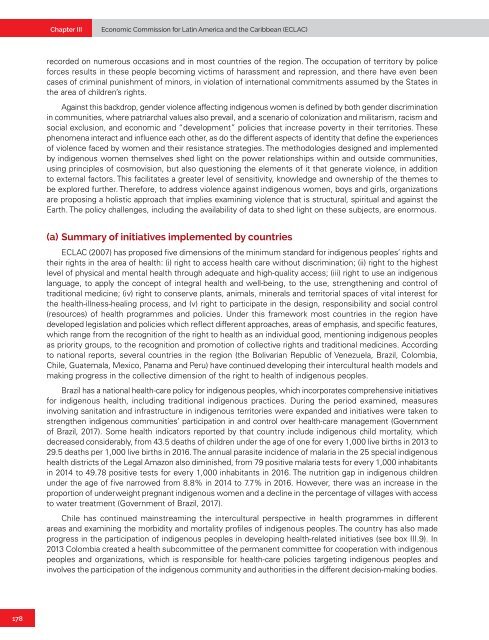Draft first regional report on the implementation of the Montevideo Consensus on Population and Development
This draft report seeks to give an account of progress in the implementation of the priority measures of the Montevideo Consensus on Population and Development in the region, as well as the differences between countries in terms of the degree of implementation. By highlighting relevant national experiences, it also seeks to facilitate the exchange of good practices among countries so that they can benefit from each other in their efforts to advance the implementation of the actions of the Montevideo Consensus.
This draft report seeks to give an account of progress in the implementation of the priority measures of the Montevideo Consensus on Population and Development in the region, as well as the differences between countries in terms of the degree of implementation. By highlighting relevant national experiences, it also seeks to facilitate the exchange of good practices among countries so that they can benefit from each other in their efforts to advance the implementation of the actions of the Montevideo Consensus.
Create successful ePaper yourself
Turn your PDF publications into a flip-book with our unique Google optimized e-Paper software.
Chapter III<br />
Ec<strong>on</strong>omic Commissi<strong>on</strong> for Latin America <strong>and</strong> <strong>the</strong> Caribbean (ECLAC)<br />
recorded <strong>on</strong> numerous occasi<strong>on</strong>s <strong>and</strong> in most countries <strong>of</strong> <strong>the</strong> regi<strong>on</strong>. The occupati<strong>on</strong> <strong>of</strong> territory by police<br />
forces results in <strong>the</strong>se people becoming victims <strong>of</strong> harassment <strong>and</strong> repressi<strong>on</strong>, <strong>and</strong> <strong>the</strong>re have even been<br />
cases <strong>of</strong> criminal punishment <strong>of</strong> minors, in violati<strong>on</strong> <strong>of</strong> internati<strong>on</strong>al commitments assumed by <strong>the</strong> States in<br />
<strong>the</strong> area <strong>of</strong> children’s rights.<br />
Against this backdrop, gender violence affecting indigenous women is defined by both gender discriminati<strong>on</strong><br />
in communities, where patriarchal values also prevail, <strong>and</strong> a scenario <strong>of</strong> col<strong>on</strong>izati<strong>on</strong> <strong>and</strong> militarism, racism <strong>and</strong><br />
social exclusi<strong>on</strong>, <strong>and</strong> ec<strong>on</strong>omic <strong>and</strong> “development” policies that increase poverty in <strong>the</strong>ir territories. These<br />
phenomena interact <strong>and</strong> influence each o<strong>the</strong>r, as do <strong>the</strong> different aspects <strong>of</strong> identity that define <strong>the</strong> experiences<br />
<strong>of</strong> violence faced by women <strong>and</strong> <strong>the</strong>ir resistance strategies. The methodologies designed <strong>and</strong> implemented<br />
by indigenous women <strong>the</strong>mselves shed light <strong>on</strong> <strong>the</strong> power relati<strong>on</strong>ships within <strong>and</strong> outside communities,<br />
using principles <strong>of</strong> cosmovisi<strong>on</strong>, but also questi<strong>on</strong>ing <strong>the</strong> elements <strong>of</strong> it that generate violence, in additi<strong>on</strong><br />
to external factors. This facilitates a greater level <strong>of</strong> sensitivity, knowledge <strong>and</strong> ownership <strong>of</strong> <strong>the</strong> <strong>the</strong>mes to<br />
be explored fur<strong>the</strong>r. Therefore, to address violence against indigenous women, boys <strong>and</strong> girls, organizati<strong>on</strong>s<br />
are proposing a holistic approach that implies examining violence that is structural, spiritual <strong>and</strong> against <strong>the</strong><br />
Earth. The policy challenges, including <strong>the</strong> availability <strong>of</strong> data to shed light <strong>on</strong> <strong>the</strong>se subjects, are enormous.<br />
(a) Summary <strong>of</strong> initiatives implemented by countries<br />
ECLAC (2007) has proposed five dimensi<strong>on</strong>s <strong>of</strong> <strong>the</strong> minimum st<strong>and</strong>ard for indigenous peoples’ rights <strong>and</strong><br />
<strong>the</strong>ir rights in <strong>the</strong> area <strong>of</strong> health: (i) right to access health care without discriminati<strong>on</strong>; (ii) right to <strong>the</strong> highest<br />
level <strong>of</strong> physical <strong>and</strong> mental health through adequate <strong>and</strong> high-quality access; (iii) right to use an indigenous<br />
language, to apply <strong>the</strong> c<strong>on</strong>cept <strong>of</strong> integral health <strong>and</strong> well-being, to <strong>the</strong> use, streng<strong>the</strong>ning <strong>and</strong> c<strong>on</strong>trol <strong>of</strong><br />
traditi<strong>on</strong>al medicine; (iv) right to c<strong>on</strong>serve plants, animals, minerals <strong>and</strong> territorial spaces <strong>of</strong> vital interest for<br />
<strong>the</strong> health-illness-healing process, <strong>and</strong> (v) right to participate in <strong>the</strong> design, resp<strong>on</strong>sibility <strong>and</strong> social c<strong>on</strong>trol<br />
(resources) <strong>of</strong> health programmes <strong>and</strong> policies. Under this framework most countries in <strong>the</strong> regi<strong>on</strong> have<br />
developed legislati<strong>on</strong> <strong>and</strong> policies which reflect different approaches, areas <strong>of</strong> emphasis, <strong>and</strong> specific features,<br />
which range from <strong>the</strong> recogniti<strong>on</strong> <strong>of</strong> <strong>the</strong> right to health as an individual good, menti<strong>on</strong>ing indigenous peoples<br />
as priority groups, to <strong>the</strong> recogniti<strong>on</strong> <strong>and</strong> promoti<strong>on</strong> <strong>of</strong> collective rights <strong>and</strong> traditi<strong>on</strong>al medicines. According<br />
to nati<strong>on</strong>al <str<strong>on</strong>g>report</str<strong>on</strong>g>s, several countries in <strong>the</strong> regi<strong>on</strong> (<strong>the</strong> Bolivarian Republic <strong>of</strong> Venezuela, Brazil, Colombia,<br />
Chile, Guatemala, Mexico, Panama <strong>and</strong> Peru) have c<strong>on</strong>tinued developing <strong>the</strong>ir intercultural health models <strong>and</strong><br />
making progress in <strong>the</strong> collective dimensi<strong>on</strong> <strong>of</strong> <strong>the</strong> right to health <strong>of</strong> indigenous peoples.<br />
Brazil has a nati<strong>on</strong>al health-care policy for indigenous peoples, which incorporates comprehensive initiatives<br />
for indigenous health, including traditi<strong>on</strong>al indigenous practices. During <strong>the</strong> period examined, measures<br />
involving sanitati<strong>on</strong> <strong>and</strong> infrastructure in indigenous territories were exp<strong>and</strong>ed <strong>and</strong> initiatives were taken to<br />
streng<strong>the</strong>n indigenous communities’ participati<strong>on</strong> in <strong>and</strong> c<strong>on</strong>trol over health-care management (Government<br />
<strong>of</strong> Brazil, 2017). Some health indicators <str<strong>on</strong>g>report</str<strong>on</strong>g>ed by that country include indigenous child mortality, which<br />
decreased c<strong>on</strong>siderably, from 43.5 deaths <strong>of</strong> children under <strong>the</strong> age <strong>of</strong> <strong>on</strong>e for every 1,000 live births in 2013 to<br />
29.5 deaths per 1,000 live births in 2016. The annual parasite incidence <strong>of</strong> malaria in <strong>the</strong> 25 special indigenous<br />
health districts <strong>of</strong> <strong>the</strong> Legal Amaz<strong>on</strong> also diminished, from 79 positive malaria tests for every 1,000 inhabitants<br />
in 2014 to 49.78 positive tests for every 1,000 inhabitants in 2016. The nutriti<strong>on</strong> gap in indigenous children<br />
under <strong>the</strong> age <strong>of</strong> five narrowed from 8.8% in 2014 to 7.7% in 2016. However, <strong>the</strong>re was an increase in <strong>the</strong><br />
proporti<strong>on</strong> <strong>of</strong> underweight pregnant indigenous women <strong>and</strong> a decline in <strong>the</strong> percentage <strong>of</strong> villages with access<br />
to water treatment (Government <strong>of</strong> Brazil, 2017).<br />
Chile has c<strong>on</strong>tinued mainstreaming <strong>the</strong> intercultural perspective in health programmes in different<br />
areas <strong>and</strong> examining <strong>the</strong> morbidity <strong>and</strong> mortality pr<strong>of</strong>iles <strong>of</strong> indigenous peoples. The country has also made<br />
progress in <strong>the</strong> participati<strong>on</strong> <strong>of</strong> indigenous peoples in developing health-related initiatives (see box III.9). In<br />
2013 Colombia created a health subcommittee <strong>of</strong> <strong>the</strong> permanent committee for cooperati<strong>on</strong> with indigenous<br />
peoples <strong>and</strong> organizati<strong>on</strong>s, which is resp<strong>on</strong>sible for health-care policies targeting indigenous peoples <strong>and</strong><br />
involves <strong>the</strong> participati<strong>on</strong> <strong>of</strong> <strong>the</strong> indigenous community <strong>and</strong> authorities in <strong>the</strong> different decisi<strong>on</strong>-making bodies.<br />
178


















